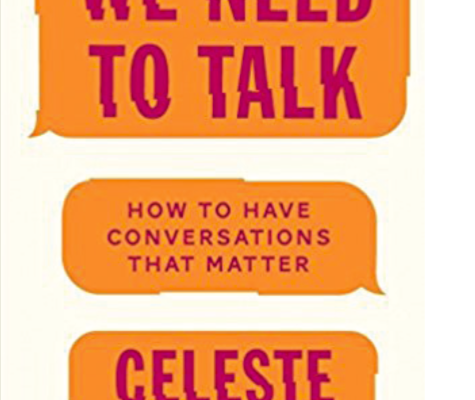This year’s common read covers conversations in ‘We Need to Talk’

By Nathan Kossoff// Staff Writer
The maningful conversations in the 21st century are in short supply, and Celeste Headlee’s self-help book, “We Need to Talk: How to Have Conversations That Matter” is here to fulfill that demand. Through the use of personal anecdotes and intellectual studies, Headlee provides insightful lessons to experience meaningful conversation. The purpose of this book is to explain the deterioration of meaningful conversations, the importance of communication, and how we as humans can improve our conversations to be more empathetic.
The beginning of the book gives background to every part of the conversation, from how speech has evolved in humans to the seriousness of communication. Headlee explains through strong and thought provoking examples of why proper communication is imperative. Such examples include the number of electronics returned per year due to non-specific instructions to lives being saved in hospitals by communicating correct information about the patient. These examples are some of the few examples Headlee uses to make her argument more compelling. An intricate part of Headlee’s steps to have a better conversation is the use of empathy during a conversation.
Empathy, as Headlee describes, is the ability to feel for an individual during a conversation, in an emotional sense. An example used in the book is a co-worker explaining the tough day the individual had, and instead of just nodding along the other person put’s themselves into their shoes. Moreover, rather than just saying the words “I feel for you,” actually trying to feel what the other person is going through is imperative for communication. Empathy as Headlee explains is only part of the equation when it comes to having a meaningful conversation.
When it comes to blaming an individual or idea for the lack of real conversations, Headlee clarifies that there is no one culprit for the downfall of meaningful conversations. From hiding true emotion behind emails and text messages or to hide behind our phones during a conversation; Headlee utilizes each chapter to inform the reader of how to face the most difficult of conversations. However, whether or not this is successful depends on each reader. Furthermore, there is still one aspect, that is not highlighted which is the breaking of our habits of emotionless conversations.
This book fails in one major way. In order to break the habit of fast emotionless responses to thought-provoking and caring responses takes a long-standing commitment. To form a habit takes a long time, but to break a habit takes even longer. Headlee failed to break down and analyze such an immense task which is disappointing as this is “how to change our conversations.”
Headlee’s use of sequential chapters to impart advice on how to have a good conversation makes for an easy to follow tutorial. The examples provided by Headlee are based on real-life scenarios, which allow the reader to relate to what Headlee is recommending to change. Although Headlee’s succeeds in many ways, there is one success, which is of note. The main achievement being Headlee’s ability to make the reading easy for anyone to read even with a very challenging subject matter, to take on such a task is bold should be of consideration.
The purpose of this self-help book, which is to recommend to the reader the seriousness of having real conversations, is achieved. However, if one feels compelled enough to go through and make a serious change in the way they have conversations this should just be the start. Headlee has spoken numerously on this subject matter and an individual who is going to make the change to have a real and meaningful conversation would find her other work on this matter quintessential for a real change. This is a self-help book I would recommend to young adults and those in working force. The subject matter will be more relatable to those in that age group. Headlee’s interweaving of information and real-life examples make for a great and easy read.